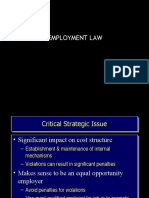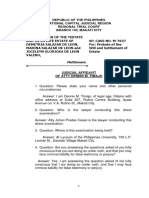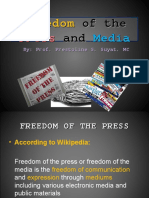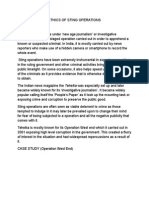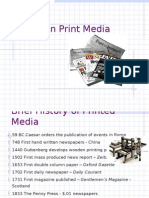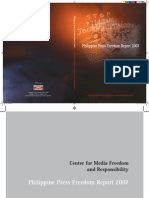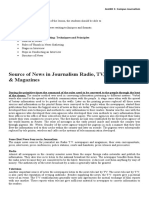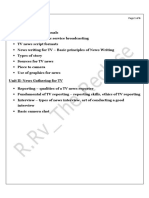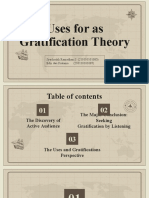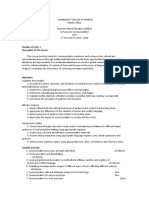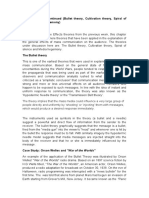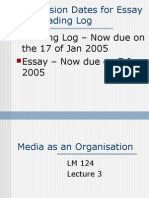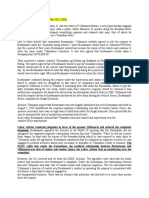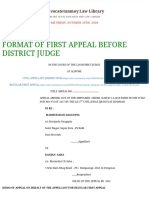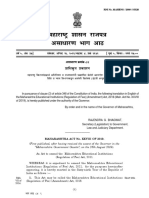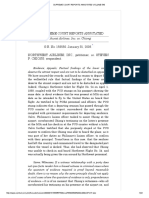0 ratings0% found this document useful (0 votes)
107 viewsPPT
PPT
Uploaded by
Gabby SantiagoThe document discusses the history of media controls in the Philippines under Ferdinand Marcos' authoritarian rule from the 1970s-1980s. It describes how Marcos declared martial law in 1972, shut down newspapers and broadcast facilities, and gained control over media content. Journalists were forced to self-censor and write in symbols to avoid punishment. While martial law was lifted in 1981, authoritarian controls remained. The assassination of Ninoy Aquino in 1983 led to the emergence of new non-establishment newspapers as people's need for news expanded.
Copyright:
© All Rights Reserved
Available Formats
Download as PPTX, PDF, TXT or read online from Scribd
PPT
PPT
Uploaded by
Gabby Santiago0 ratings0% found this document useful (0 votes)
107 views12 pagesThe document discusses the history of media controls in the Philippines under Ferdinand Marcos' authoritarian rule from the 1970s-1980s. It describes how Marcos declared martial law in 1972, shut down newspapers and broadcast facilities, and gained control over media content. Journalists were forced to self-censor and write in symbols to avoid punishment. While martial law was lifted in 1981, authoritarian controls remained. The assassination of Ninoy Aquino in 1983 led to the emergence of new non-establishment newspapers as people's need for news expanded.
Original Description:
deresang
Original Title
ppt
Copyright
© © All Rights Reserved
Available Formats
PPTX, PDF, TXT or read online from Scribd
Share this document
Did you find this document useful?
Is this content inappropriate?
The document discusses the history of media controls in the Philippines under Ferdinand Marcos' authoritarian rule from the 1970s-1980s. It describes how Marcos declared martial law in 1972, shut down newspapers and broadcast facilities, and gained control over media content. Journalists were forced to self-censor and write in symbols to avoid punishment. While martial law was lifted in 1981, authoritarian controls remained. The assassination of Ninoy Aquino in 1983 led to the emergence of new non-establishment newspapers as people's need for news expanded.
Copyright:
© All Rights Reserved
Available Formats
Download as PPTX, PDF, TXT or read online from Scribd
Download as pptx, pdf, or txt
0 ratings0% found this document useful (0 votes)
107 views12 pagesPPT
PPT
Uploaded by
Gabby SantiagoThe document discusses the history of media controls in the Philippines under Ferdinand Marcos' authoritarian rule from the 1970s-1980s. It describes how Marcos declared martial law in 1972, shut down newspapers and broadcast facilities, and gained control over media content. Journalists were forced to self-censor and write in symbols to avoid punishment. While martial law was lifted in 1981, authoritarian controls remained. The assassination of Ninoy Aquino in 1983 led to the emergence of new non-establishment newspapers as people's need for news expanded.
Copyright:
© All Rights Reserved
Available Formats
Download as PPTX, PDF, TXT or read online from Scribd
Download as pptx, pdf, or txt
You are on page 1of 12
Authoritarian Controls and
News Media in the
Philippines
By Joel Dresang
Short Background on Philippine
Media
Law of Philippine media was modelled after
the constitutional provisions of the
American Colonialists.
In 1960s Philippine Government was
enacting to protect journalists and their
sources of information.
In 1966 a study by Ralph L. Lowenstein
classified the Philippine media among the
most free in the world.
Media in the Philippines was free wheeling
in early 1970s according to Hernando
Gonzales.
Advantage: Media is a catalyst in the
growth and development of the Philippines.
Disadvantage: A lot of publications are
exaggerated especially in the reports of
crimes and official improprieties (1970s
worsening economic conditions).
Media Under Martial Law
1971 According to Marcos, the media is nonobjective.
September 20, 1972 Chino Lagman said that the
ambush of Philippine Defence Minister was a
staged event.
September 21, 1972 Marcos declared Martial
Law and resulted to the close down of print and
broadcast facilities in the Philippines.
Manila Times, published by Joaquin P. Roces, was
shut down.
Martial Law government made a
communications vacuum where only Pro-Marcos
newspaper are allowed.
Chosen communications and broadcast facilities
were the only one allowed to operate.
Marcos then gained control of the content of
the Philippine Media.
Late 1974, the council that controls the media
was dismantled but there was a new order to
the journalists.
The media became more passive.
In January 1981, Marcos then lifted Martial
law but authoritarian controls had been
lifted only in name.
The lack of press freedom
has made many of us, who
have worked all these years
under martial law, tend to
censor ourselves
automatically. Antonio
Nieva.
December 1982, WE Forum (press) was
stopped due to the questioning of the most
decorated veteran of World War II (Marcos).
February 1983, first Philippine press strike
was upheld it was leaded by Antonio
Nieva. After a few months, he was arrested
due to destabilizing the government.
March 1983, International Press Institute
noted that the press controls were
liberalized.
None of the journalists, who got caught,
were convicted according to Chibu Lagman
Journalists learned how to write in symbols
because they cannot explicitly write the
hard facts for how many years.
August 1983, media now is slowly getting back
on track, but not on major newspapers and
televisions.
August 21, Ninoy Aquino was assassinated.
Different news were released.
Enrique Zobel had no respect for the Philippine
Media because they might just have been
bribed.
Vicente Jayme, a business leader, pressured the
established media companies.
Within a few months of the Aquino
Assassination, ten new non-establishment
newspapers joined Malaya in the Philippine
media market
Veritas Weekly was formed.
In October 1983, Philippine Times was
closed because of publishing a series
of articles blaming the soldiers for the
assassination of the Ninoy.
According to Doeppers, newspapers do
tend to expand when people
extraordinarily needs for news.
You might also like
- DOJ v. Jackson Township Settlement AgreementDocument72 pagesDOJ v. Jackson Township Settlement AgreementRise Up Ocean CountyNo ratings yet
- Development CommunicationDocument3 pagesDevelopment CommunicationNoe S. Elizaga Jr.No ratings yet
- FMA 3:research Proposal: Submitted byDocument13 pagesFMA 3:research Proposal: Submitted byMelvin EspinedaNo ratings yet
- Jeffrey A. Mello 4e - Chapter 7 - Employment LawDocument34 pagesJeffrey A. Mello 4e - Chapter 7 - Employment LawHuman Resource ManagementNo ratings yet
- Diño V CA GuarantyDocument2 pagesDiño V CA GuarantyRed HaleNo ratings yet
- Judicial Affidavit of Atty Dennis M. TimajoDocument9 pagesJudicial Affidavit of Atty Dennis M. TimajoMatthew WittNo ratings yet
- Freedom of The Press and Media - Prof. Prestoline S. SuyatDocument39 pagesFreedom of The Press and Media - Prof. Prestoline S. SuyatkathyNo ratings yet
- Ethics of Sting OperationsDocument2 pagesEthics of Sting OperationsNeha GeorgeNo ratings yet
- Trends in Print MediaDocument18 pagesTrends in Print MediaRon Newman80% (5)
- CMFR Philippine Press Freedom Report 2007Document81 pagesCMFR Philippine Press Freedom Report 2007Center for Media Freedom & ResponsibilityNo ratings yet
- Philippine Press Freedom Primer (2007)Document20 pagesPhilippine Press Freedom Primer (2007)Center for Media Freedom & ResponsibilityNo ratings yet
- 4 Eras of Mass Communication TheoriesDocument15 pages4 Eras of Mass Communication TheoriesMuhammad Faraz Imam100% (1)
- InterviewingDocument50 pagesInterviewingFarhad HashemiNo ratings yet
- From Hard To Soft News StandardsDocument22 pagesFrom Hard To Soft News StandardsÉbida SantosNo ratings yet
- Media and Power in Southeast AsiaDocument61 pagesMedia and Power in Southeast AsiachrstncortezNo ratings yet
- J301F Fundamental Issues in Journalism Spring 2017: Shuninglu@utexas - Edu Martin - Riedl@utexas - EduDocument4 pagesJ301F Fundamental Issues in Journalism Spring 2017: Shuninglu@utexas - Edu Martin - Riedl@utexas - EduCriton PlatoNo ratings yet
- What Is TAMDocument8 pagesWhat Is TAMravi kumar buswala 123No ratings yet
- News AgencyDocument18 pagesNews AgencyDEEPAK GROVER100% (1)
- Module OneDocument13 pagesModule OnetemesgenNo ratings yet
- Item TestDocument9 pagesItem TestKatz EscañoNo ratings yet
- Source of News in Journalism Radio, TV, Newspapers & MagazinesDocument12 pagesSource of News in Journalism Radio, TV, Newspapers & MagazinesRaquel LimboNo ratings yet
- Media ConvergenceDocument14 pagesMedia ConvergenceMohamed Nageeb SalemNo ratings yet
- RCI 103 Advertising Principles and PracticesDocument7 pagesRCI 103 Advertising Principles and Practicesdindo monilNo ratings yet
- Communication Theory OutlineDocument5 pagesCommunication Theory OutlineAmratHaqNo ratings yet
- Digital Culture & Society-Ppt 2Document21 pagesDigital Culture & Society-Ppt 2Muhamad IsnainiNo ratings yet
- Philippines: Media Market DescriptionDocument4 pagesPhilippines: Media Market DescriptionZeno MartinezNo ratings yet
- KBP Broadcast CodeDocument3 pagesKBP Broadcast CodeKirz SerranoNo ratings yet
- All India RadioDocument20 pagesAll India RadioEsther ThottanNo ratings yet
- Psa ReportDocument18 pagesPsa ReportMerry Jane MirafuentesNo ratings yet
- BroadcastDocument6 pagesBroadcastjunny_kumNo ratings yet
- Investigative Journalism in EducationDocument13 pagesInvestigative Journalism in EducationHenry MapesaNo ratings yet
- Journalism: Findings Hard and Soft News: A Review of Concepts, Operationalizations and KeyDocument20 pagesJournalism: Findings Hard and Soft News: A Review of Concepts, Operationalizations and Keyfranklin_ramirez_80% (1)
- Mass Comm.Document16 pagesMass Comm.AmmarahNo ratings yet
- Media Ecology Theory: Marshall McluhanDocument12 pagesMedia Ecology Theory: Marshall McluhanEdgar Eduardo Morales OrtegaNo ratings yet
- 1) Introduction To Communication - Media and SocietyDocument12 pages1) Introduction To Communication - Media and SocietyAhmad WaseemNo ratings yet
- The Print RevolutionDocument1 pageThe Print Revolutioncanbalaban365No ratings yet
- The Magic Bullet Theory (Imc)Document3 pagesThe Magic Bullet Theory (Imc)Abhishri AgarwalNo ratings yet
- Role of Media During ElectionsDocument4 pagesRole of Media During ElectionsMir Ahmad FerozNo ratings yet
- Beginning of The Research: Writing Chapter IDocument17 pagesBeginning of The Research: Writing Chapter IAiza San Pedro Santos100% (1)
- A Theory of Development CommunicationDocument24 pagesA Theory of Development CommunicationEzekiel T. MostieroNo ratings yet
- Data CollectionDocument11 pagesData Collectionanjuhooda1987No ratings yet
- Role of MediaDocument13 pagesRole of MedianylashahidNo ratings yet
- Communication Research Methods SyllabusDocument5 pagesCommunication Research Methods SyllabusMatthew J. Kushin, Ph.D.No ratings yet
- Lesson 03 - Lesson 06Document38 pagesLesson 03 - Lesson 06ReseNo ratings yet
- Inverted Pyramid: Writing For Comprehension Summary: Start Content With The Most Important Piece ofDocument11 pagesInverted Pyramid: Writing For Comprehension Summary: Start Content With The Most Important Piece ofRamakrishnaDiddiNo ratings yet
- Theories of CMC PDFDocument37 pagesTheories of CMC PDFFilip KrstevskiNo ratings yet
- Uses For As Gratification TheoryDocument26 pagesUses For As Gratification TheoryEdzi DwiNo ratings yet
- Purposive CommunicationDocument2 pagesPurposive CommunicationYhet Ardales100% (1)
- Target AudienceDocument2 pagesTarget AudienceShivani Samel100% (1)
- Syllabus For Media and Information Literacy (Revised, 2018)Document3 pagesSyllabus For Media and Information Literacy (Revised, 2018)Marlon Nombrado100% (1)
- Yellow and Green School Supplies Ice Breaker Human Bingo Education PresentationDocument11 pagesYellow and Green School Supplies Ice Breaker Human Bingo Education PresentationMuhamad Naufal RNo ratings yet
- Advertising HistoryDocument11 pagesAdvertising HistoryShahzad ShahidNo ratings yet
- Art of Reading A Journal Article - Methodically and EffectivelyDocument4 pagesArt of Reading A Journal Article - Methodically and Effectivelyretno wulandariNo ratings yet
- Theories of CommunicationDocument15 pagesTheories of CommunicationGwenneth Bachus100% (1)
- Digital Journalism: A Rigorous, Enriching ProgramDocument2 pagesDigital Journalism: A Rigorous, Enriching Programjohn_lonerNo ratings yet
- Writing For New MediaDocument17 pagesWriting For New MediaMichelle AnteneroNo ratings yet
- Effects Theories Continued (Bullet Theory, Cultivation Theory, Spiral of Silence, Media Hegemony)Document6 pagesEffects Theories Continued (Bullet Theory, Cultivation Theory, Spiral of Silence, Media Hegemony)WAQAS AHMEDNo ratings yet
- Media As An Organisation LM124Document19 pagesMedia As An Organisation LM124Tommy KC100% (4)
- Limitations of Media Effects ParadigmsDocument3 pagesLimitations of Media Effects ParadigmsSabir Ali Nastran75% (4)
- Enrichment Student Proposals Clinical Research PDFDocument2 pagesEnrichment Student Proposals Clinical Research PDFSethNo ratings yet
- News ValuesDocument28 pagesNews ValuesRia IsidroNo ratings yet
- Audience As Determinant of Production and Diction of Text in Journalism.Document9 pagesAudience As Determinant of Production and Diction of Text in Journalism.chibamba shimulizeNo ratings yet
- 18 Corys Speech Before The US Congress PPT 1Document17 pages18 Corys Speech Before The US Congress PPT 1Vincent Ian TañaisNo ratings yet
- ia-2021.01.21-14.19-CGU Motor Accident Claim FormDocument10 pagesia-2021.01.21-14.19-CGU Motor Accident Claim FormJennifer McPhersonNo ratings yet
- UntitledDocument3 pagesUntitledReyes, Ann Margareth A.No ratings yet
- Central Philippine University Vs CA July 17, 1995Document5 pagesCentral Philippine University Vs CA July 17, 1995Joshua Janine LugtuNo ratings yet
- June 2022 Module 1 (Question Paper)Document4 pagesJune 2022 Module 1 (Question Paper)damian gonzalezNo ratings yet
- G.R. No. 172507Document30 pagesG.R. No. 172507Danica GodornesNo ratings yet
- DBM Presentation - 23rd Annual Convention-Janet B. Abuel PDFDocument19 pagesDBM Presentation - 23rd Annual Convention-Janet B. Abuel PDFJacqueline P AlfaroNo ratings yet
- Wills & Estates Fundamentals 9.1Document15 pagesWills & Estates Fundamentals 9.1SherryNo ratings yet
- Political Law NachuraDocument4 pagesPolitical Law NachuraRemy Rose Alegre100% (1)
- Reconstruction Clzed Notes CDocument73 pagesReconstruction Clzed Notes Capi-3260234940% (2)
- Block 1 MRDE 002 Unit 2Document25 pagesBlock 1 MRDE 002 Unit 2Viswanadh PeriNo ratings yet
- SettlementLetter (117) - BRITTODocument2 pagesSettlementLetter (117) - BRITTOadvshahithNo ratings yet
- 2 Professional Code of Ethics PDFDocument11 pages2 Professional Code of Ethics PDFChitradevi RamooNo ratings yet
- Minnesota House of RepresentativesDocument3 pagesMinnesota House of RepresentativesSally Jo SorensenNo ratings yet
- Role of Police in Criminal Justice System: Hidayatullah National Law UniversityDocument21 pagesRole of Police in Criminal Justice System: Hidayatullah National Law UniversitySaurabh BaraNo ratings yet
- FORMAT OF FIRST APPEAL BEFORE DISTRICT JUDGE - Advocatetanmoy Law LibraryDocument4 pagesFORMAT OF FIRST APPEAL BEFORE DISTRICT JUDGE - Advocatetanmoy Law LibraryAkshaysinh ChudasamaNo ratings yet
- SUEX OTC Sro - Prague Articles of IncorporationDocument8 pagesSUEX OTC Sro - Prague Articles of IncorporationFile 411No ratings yet
- CUSTODIAL ATROCITIES, HUMAN RIGHTS AND THE JUDICIARY - Jitendra MishraDocument14 pagesCUSTODIAL ATROCITIES, HUMAN RIGHTS AND THE JUDICIARY - Jitendra MishrafaarehaNo ratings yet
- 91 Fortune V CADocument1 page91 Fortune V CARegina CoeliNo ratings yet
- Mah. Act No. Xxviii of 2019Document5 pagesMah. Act No. Xxviii of 2019Arnav PankhadeNo ratings yet
- Two Wheeler Comprehensive Policy New PDFDocument2 pagesTwo Wheeler Comprehensive Policy New PDFhappy maheruNo ratings yet
- Robinson V BlandDocument8 pagesRobinson V BlandZayn ParkerNo ratings yet
- Land Notes 88Document23 pagesLand Notes 88Bella SallehNo ratings yet
- Or Indirectly Obstructs, Defeats, Violates or in Any Manner Impedes or ImpairsDocument2 pagesOr Indirectly Obstructs, Defeats, Violates or in Any Manner Impedes or ImpairsOne TwoNo ratings yet
- Activity: Mobilelegends Tournament Rationale: 3. ConductDocument3 pagesActivity: Mobilelegends Tournament Rationale: 3. ConductAries Castañas-GarciaNo ratings yet
- Andhra Pradesh Shops and Establishments Act, 1988Document26 pagesAndhra Pradesh Shops and Establishments Act, 1988sakhigunti0% (1)
- NorthwestDocument22 pagesNorthwestJayrell Radlyn CastorNo ratings yet



